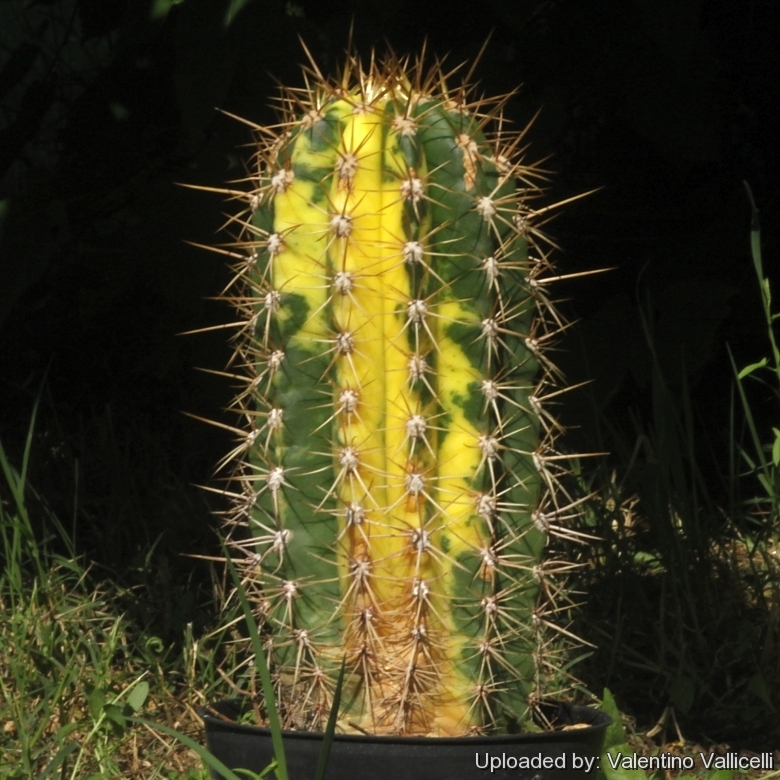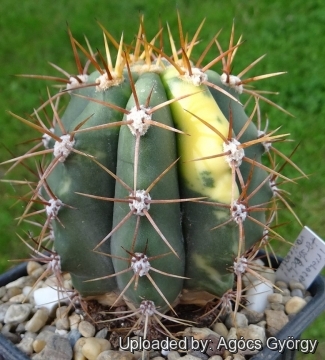Accepted Scientific Name: Echinopsis terscheckii (J.Parm. ex Pfeiff.) H.Friedrich & G.D.Rowley
I.O.S. Bull. 3(3): 98 (1974)

Echinopsis terscheckii f. variegata Photo by: Valentino Vallicelli
Origin and Habitat: Garden origin. The original natural habitat of this species is Argentina (Catamarca, Salta, Jujuy, La Rioja, San Juan and Tucumán provinces) and Bolivia (Tarija) where it grows at altitudes between 800 and 2,000 metres above sea level.
Synonyms:
See all synonyms of Echinopsis terscheckii
back
Accepted name in llifle Database:Echinopsis terscheckii (J.Parm. ex Pfeiff.) H.Friedrich & G.D.RowleyI.O.S. Bull. 3(3): 98 (1974)Synonymy: 9
back
Common Names include:
ENGLISH: San Pedro, Cardon grande cactus, Argentine saguaro, South American saguaro
PERSIAN (فارسی): اکینوپسیس ترسککی
SPANISH (Español): Cardon Grande, Cardón santos, San Pedro, Cardón
Description: Echinopsis terscheckiiSN|28691]]SN|8744]] best known in cultivation as Trichocereus terscheckiiSN|8746]]SN|8746]] is a huge treelike cactus species, called in Argentina cardon grande. At first columnar, and usually in age with numerous large arms, 10 to 12 meters high.
Variegated form: The variegated form (Echinopsis terscheckii f. variegataSN|8744]]SN|28691]]) has sectors, patches or stripes with distinct shades of yellow. A very few variegated plants sprout unpredictably time by time among normal green seedling and are very rare. Plants with variegated stems are often attractive and - despite to their beauty - are very rare and sought after by collectors. It is a strong growing variegated cactus that will slowly forms tall specimens several metres tall with age.
Stem: Trunk up to 45 cm in diameter, distinct woody, brancing well above ground level; branches several cylindrical, columnar, erect, 10 to 20 cm in diameter.
Ribs: 8 to 14(-18), obtuse, prominent, 2 to 4 cm high, obtuse.
Areoles: Large, 1 to 1.5 cm in diameter, brownish felted, 2 to 3 cm apart.
Spines: 8 to 15, often more in older areoles, yellowish to brownish, subulate, yellow, 1-8 cm or more long.
Flowers: Very large, nocturnal , borne laterally, bell shaped to funnelform, white, 15 to 20 cm long, 12.5 cm broad; inner perianth-segments oblong, 7 cm. long, acute, white; outer perianth-segments dark red to greenish, pericarpel green, scales on the pericarpel and flower-tube ovate, mucronate-tipped, their axils filled with long whitish or brown wool. Flowers appear to be pollinated by bats.
Blooming season: The plants flower at various times of the year, but primarily during the rainy season (Summer).
Fruits: Globose or oblong green to blue about 1.3-5 cm in diameter, with acute scales woolly in the axils. Residents of their habitat have reported that the fruits are edible, but inferior to those of the pasacana.
Seeds: Dark-brown to almost black, oval approximately 0.76-1.5 mm long and up to 1.1 mm wide, somewhat warty tessellate.
Subspecies, varieties, forms and cultivars of plants belonging to the Echinopsis terscheckii group
 Echinopsis terscheckii (J.Parm. ex Pfeiff.) H.Friedrich & G.D.Rowley: is a huge treelike cactus speciesat first columnar, and usually in age with numerous large arms, 10 to 12 meters high. Distribution: Argentina (Catamarca, Salta, Jujuy, La Rioja, San Juan and Tucumán provinces) and Bolivia (Tarija).
Echinopsis terscheckii (J.Parm. ex Pfeiff.) H.Friedrich & G.D.Rowley: is a huge treelike cactus speciesat first columnar, and usually in age with numerous large arms, 10 to 12 meters high. Distribution: Argentina (Catamarca, Salta, Jujuy, La Rioja, San Juan and Tucumán provinces) and Bolivia (Tarija). Echinopsis terscheckii f. variegata hort.: variegated form. Stems have sectors, patches or stripes with distinct shades of yellow.
Echinopsis terscheckii f. variegata hort.: variegated form. Stems have sectors, patches or stripes with distinct shades of yellow.  Echinopsis werdermanniana (Backeb.) H.Friedrich & G.D.Rowley: has 10-14 ribs, 8 radial and 1(-2) central spines, flowers nearly apical up to 22 cm long. Distribution: Bolivia, Charcoma Valley, east of Tupiza and Potosi.
Echinopsis werdermanniana (Backeb.) H.Friedrich & G.D.Rowley: has 10-14 ribs, 8 radial and 1(-2) central spines, flowers nearly apical up to 22 cm long. Distribution: Bolivia, Charcoma Valley, east of Tupiza and Potosi.
Bibliography: Major references and further lectures.
1) Nathaniel Lord Britton, Joseph Nelson Rose “Cactaceae: Descriptions and Illustrations of Plants of the Cactus Family” vol. 1 The Carnegie Institution of Washington, Washington 1919
2) Edward Anderson “The Cactus family” Timber Press, Incorporated, 2001
3) James Cullen, Sabina G. Knees, H. Suzanne Cubey "The European Garden Flora Flowering Plants: A Manual for the Identification of Plants Cultivated in Europe, Both Out-of-Doors and Under Glass" Cambridge University Press, 11/Aug/2011
4) David R Hunt; Nigel P Taylor; Graham Charles; International Cactaceae Systematics Group. "The New Cactus Lexicon" dh books, 2006
5) Urs Eggli, Leonard E. Newton: “Etymological Dictionary of Succulent Plant Names” Birkhäuser 2004
6) Ortega-Baes, P. & Lowry, M. 2013. Echinopsis terscheckii. The IUCN Red List of Threatened Species. Version 2014.2. <www.iucnredlist.org>. Downloaded on 11 September 2014.
7) Wikipedia contributors. "Echinopsis terscheckii." Wikipedia, The Free Encyclopedia. Wikipedia, The Free Encyclopedia, 6 Sep. 2013. Web. 11 Sep. 2014.
8) Gibson, Arthur C. y Park S. Nobel “The Cactus Primer.” Cambridge, Massachusetts: Harvard University Press. 1986
9) Navarro, G. “Catálago ecológico preliminar de las cactáceas de Bolivia.” Lazaroa 17: 33–84. 1996
10) Dr. Pfeiffer: “Beschreibung einiger neuer Cacteen.” In: Allgemeine Gartenzeitung. 5(47): 370 25. November 1837.
11) Gordon Douglas Rowley: “Reunion of the genus Echinopsis.” In: IOS Bulletin. Journal of the International Organization for Succulent Plant Study. 3(3): 98 1974
12) "Checklist of CITES Species" Part 1 CITES species index, 2011
13) David Yetman “The Great Cacti: Ethnobotany & Biogeography” University of Arizona Press, 2007
 Echinopsis terscheckii f. variegata Photo by: Agócs György
Echinopsis terscheckii f. variegata Photo by: Agócs GyörgySend a photo of this plant.The gallery now contains thousands of pictures, however it is possible to do even more. We are, of course, seeking photos of species not yet shown in the gallery but not only that, we are also looking for better pictures than those already present.
Read More... Cultivation and Propagation: Variegated cacti are regarded as choice and difficult in cultivation, but despite that many of them are relatively easy to grow. But be aware that they cannot tolerate prolonged exposure to direct sun light (especially during the hottest summer days), so grow them in half-shade or under filtered sun. They are sometime seen as grafted plants, but some of this colourful plants (those with some chlorophyll) are able to grow on their own roots and are priced by collectors.
Soil: Use mineral well-permeable substratum with little organic matter (peat, humus).
Watering: Water sparingly from March till October, and keep perfectly dry in winter, at temperatures from 5 to 15 degrees centigrade. (In general these plants are more tender and cannot endure freezing temperatures). In the rest period no high atmospheric humidity!!
Propagation: By seeds, grafting or cutting. Because the variegation is due to the presence of two kinds of plant tissue, propagating the plant must be by a vegetative method of propagation that preserves both types of tissue in relation to each other. A most common way way to cultivate this partially de-coloured cultivars is to graft them onto another cactus which has chlorophyll and which will provide sugar to the mutant scion. The chlorophyll containing bottom part of the graft, called the stock, can be any number of different columnar cactus species.
Remarks: Seeds from variegated parents often give raise to some variegated seedlings too.












